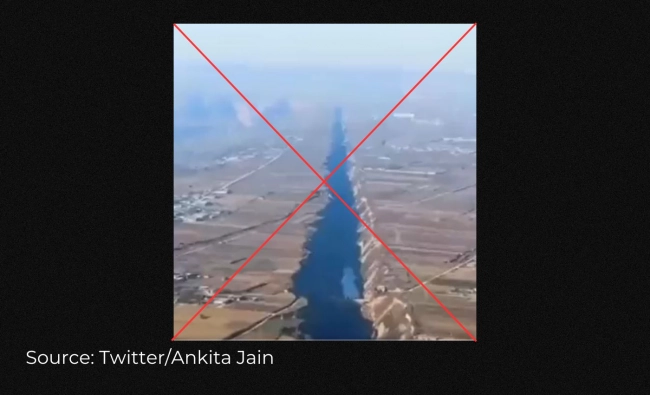By: Annet Preethi Furtado
February 24 2023
False: The video depicts a fracture in the earth's crust caused by recent earthquakes in Turkey.

The Verdict False
This old video shows the Loess Plateau in China's Pinglu County and is unrelated to the recent earthquake that hit Turkey in February 2023.
Context
Even as Turkey and Syria attempt to recover from the extensive damage and fatalities brought about by the February 6 earthquakes that ravaged the nations, two more earthquakes of magnitude 6.4 and 5.8 struck Turkey's Hatay region on February 20. A report by AP quoted Turkey's disaster management organization saying that the recent 6.4-magnitude earthquake in Turkey left six people dead, 18 in serious condition, and 294 injured.
Since the first earthquake in Turkey and Syria, several misleading videos and images have cropped up on social media that were either linked to the quakes or purported to show their aftermath. Similarly, an eight-second video posted on social media after the February 20 earthquake claimed to show aerial footage of a deep crack in Turkey caused by the recent earthquake. On Twitter, the video was captioned, "A new earthquake of magnitude 6.4 has just occurred. This is reported to be the fracture of the earth's crust after earthquake." Another Twitter user posted the video with the caption "Turkey Syria Earthquake Caused 300 km Long Crack in Earth's Crust" but claimed in a follow-up tweet that she was unaware if the claim was fake. Several other social media users shared the same video, which has hundreds of likes, comments, and thousands of views.
Contrary to the post's claim, this video neither depicts Turkey nor is it recent.
In Fact
A reverse image search on one of the video's keyframes led us to another similar version of a clip with a musical soundtrack posted by an Instagram account on December 6, 2021. This confirmed that the video predates the earthquakes in Turkey and Syria.
We also found a similar video on TikTok from October 2022 with Chinese subtitles and a narrative voiceover. The Chinese caption of the TikTok video, translated to English, read: ''A straight gully on the Pinglu plateau in Shanxi divides the houses on both sides into two. Is it formed by the crustal changes over hundreds of millions of years, or is it formed by other reasons?.'' Further, the video's Chinese voiceover describes a deep gulf that is 20 kilometers long in Pinglu County, Yuncheng, Shanxi, and questions what caused the gulf, calling it a mystery. Further, we found that the same TikTok video was uploaded to YouTube by a Chinese account with the description claiming that the visuals are from the Pinglu Country. However, in the viral tweets, this YouTube video's fragments between 0:04 and 0:25 were mislabeled as visuals of the Turkey earthquake.
Furthermore, Logically geolocated the crack in the Pinglu Country on Google Maps and found that this Chinese region's geographical characteristics match those seen in the YouTube video. We observed that about twenty seconds into the YouTube video, there is a white structure on the right side of the crack and what appears to be buildings on the crack's left. We were able to locate the same on Google Earth and Google Maps, and these physical elements resemble that around the Loess Plateau. A structure with a blue roof within one of the fractures and the road patterns seen on Google Earth are other features that match the video. This proved that the video was captured in this Chinese region.
Speaking to The Associated Press, Steve Gao, professor of geophysics at the Missouri University of Science and Technology, said, ''The cracks are definitely not related to the recent earthquakes in Turkey," adding, "They are from Pinglu County in Shanxi Province." An Yin, a professor of geology at the University of California, Los Angeles, told the news agency that the video showed the Loess Plateau.
Loess Plateau is known for its deep loess. According to National Geographic, loess is windblown sand that is light and loosely packed, unlike other soils, primarily formed by wind or when glaciers crush rocks to a fine powder. According to the article 'Soil and water loss from the Loess Plateau in China,' published on Science Direct, an online hub for academic research, owing to the unique geographic topography, soil and climatic conditions, and human activity, there has been substantial soil erosion in the Loess Plateau. River erosion and not earthquakes caused the cracks in this region.
According to a report by Reuters, the February 6 earthquakes and the aftershocks did cause ruptures on the surface of the earth in Turkey and northern Syria. Among others, scientists at the United States Geological Survey (USGS) have documented two long cracks stretching hundreds of kilometers in the region. However, the viral video shows river erosion in China's Loess Plateau and is unrelated to the earthquakes.
The Verdict
This video showing cracks in the earth's surface is from China's Pinglu area and has nothing to do with the devastating earthquakes that struck Turkey and Syria. Therefore, we have marked the claim as false.


